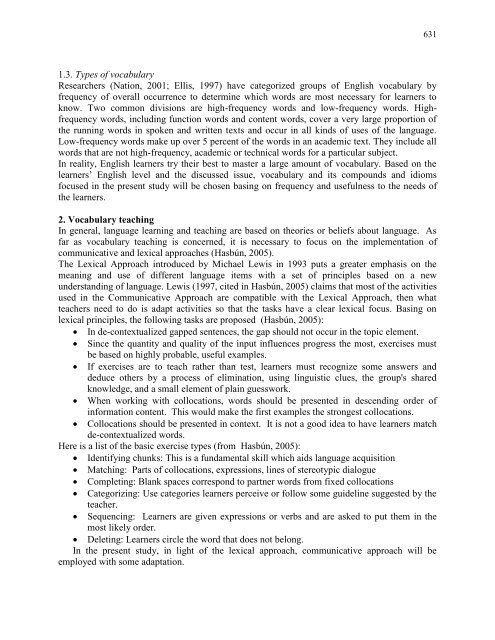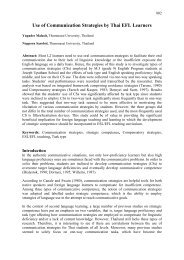The Effects of Semantic Mapping on Vocabulary Memorizing
The Effects of Semantic Mapping on Vocabulary Memorizing
The Effects of Semantic Mapping on Vocabulary Memorizing
You also want an ePaper? Increase the reach of your titles
YUMPU automatically turns print PDFs into web optimized ePapers that Google loves.
1.3. Types <str<strong>on</strong>g>of</str<strong>on</strong>g> vocabulary<br />
Researchers (Nati<strong>on</strong>, 2001; Ellis, 1997) have categorized groups <str<strong>on</strong>g>of</str<strong>on</strong>g> English vocabulary by<br />
frequency <str<strong>on</strong>g>of</str<strong>on</strong>g> overall occurrence to determine which words are most necessary for learners to<br />
know. Two comm<strong>on</strong> divisi<strong>on</strong>s are high-frequency words and low-frequency words. Highfrequency<br />
words, including functi<strong>on</strong> words and c<strong>on</strong>tent words, cover a very large proporti<strong>on</strong> <str<strong>on</strong>g>of</str<strong>on</strong>g><br />
the running words in spoken and written texts and occur in all kinds <str<strong>on</strong>g>of</str<strong>on</strong>g> uses <str<strong>on</strong>g>of</str<strong>on</strong>g> the language.<br />
Low-frequency words make up over 5 percent <str<strong>on</strong>g>of</str<strong>on</strong>g> the words in an academic text. <str<strong>on</strong>g>The</str<strong>on</strong>g>y include all<br />
words that are not high-frequency, academic or technical words for a particular subject.<br />
In reality, English learners try their best to master a large amount <str<strong>on</strong>g>of</str<strong>on</strong>g> vocabulary. Based <strong>on</strong> the<br />
learners’ English level and the discussed issue, vocabulary and its compounds and idioms<br />
focused in the present study will be chosen basing <strong>on</strong> frequency and usefulness to the needs <str<strong>on</strong>g>of</str<strong>on</strong>g><br />
the learners.<br />
2. <strong>Vocabulary</strong> teaching<br />
In general, language learning and teaching are based <strong>on</strong> theories or beliefs about language. As<br />
far as vocabulary teaching is c<strong>on</strong>cerned, it is necessary to focus <strong>on</strong> the implementati<strong>on</strong> <str<strong>on</strong>g>of</str<strong>on</strong>g><br />
communicative and lexical approaches (Hasbún, 2005).<br />
<str<strong>on</strong>g>The</str<strong>on</strong>g> Lexical Approach introduced by Michael Lewis in 1993 puts a greater emphasis <strong>on</strong> the<br />
meaning and use <str<strong>on</strong>g>of</str<strong>on</strong>g> different language items with a set <str<strong>on</strong>g>of</str<strong>on</strong>g> principles based <strong>on</strong> a new<br />
understanding <str<strong>on</strong>g>of</str<strong>on</strong>g> language. Lewis (1997, cited in Hasbún, 2005) claims that most <str<strong>on</strong>g>of</str<strong>on</strong>g> the activities<br />
used in the Communicative Approach are compatible with the Lexical Approach, then what<br />
teachers need to do is adapt activities so that the tasks have a clear lexical focus. Basing <strong>on</strong><br />
lexical principles, the following tasks are proposed (Hasbún, 2005):<br />
In de-c<strong>on</strong>textualized gapped sentences, the gap should not occur in the topic element.<br />
Since the quantity and quality <str<strong>on</strong>g>of</str<strong>on</strong>g> the input influences progress the most, exercises must<br />
be based <strong>on</strong> highly probable, useful examples.<br />
If exercises are to teach rather than test, learners must recognize some answers and<br />
deduce others by a process <str<strong>on</strong>g>of</str<strong>on</strong>g> eliminati<strong>on</strong>, using linguistic clues, the group's shared<br />
knowledge, and a small element <str<strong>on</strong>g>of</str<strong>on</strong>g> plain guesswork.<br />
When working with collocati<strong>on</strong>s, words should be presented in descending order <str<strong>on</strong>g>of</str<strong>on</strong>g><br />
informati<strong>on</strong> c<strong>on</strong>tent. This would make the first examples the str<strong>on</strong>gest collocati<strong>on</strong>s.<br />
Collocati<strong>on</strong>s should be presented in c<strong>on</strong>text. It is not a good idea to have learners match<br />
de-c<strong>on</strong>textualized words.<br />
Here is a list <str<strong>on</strong>g>of</str<strong>on</strong>g> the basic exercise types (from Hasbún, 2005):<br />
Identifying chunks: This is a fundamental skill which aids language acquisiti<strong>on</strong><br />
Matching: Parts <str<strong>on</strong>g>of</str<strong>on</strong>g> collocati<strong>on</strong>s, expressi<strong>on</strong>s, lines <str<strong>on</strong>g>of</str<strong>on</strong>g> stereotypic dialogue<br />
Completing: Blank spaces corresp<strong>on</strong>d to partner words from fixed collocati<strong>on</strong>s<br />
Categorizing: Use categories learners perceive or follow some guideline suggested by the<br />
teacher.<br />
Sequencing: Learners are given expressi<strong>on</strong>s or verbs and are asked to put them in the<br />
most likely order.<br />
Deleting: Learners circle the word that does not bel<strong>on</strong>g.<br />
In the present study, in light <str<strong>on</strong>g>of</str<strong>on</strong>g> the lexical approach, communicative approach will be<br />
employed with some adaptati<strong>on</strong>.<br />
631






